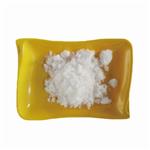Description
m-Toluidine is an aromatic amine compound widely used as a dye raw material, but the aromatic amines of m-Toluidine and o-anisidine have shown damage to the bladder mucosa and potential carcinogenicity
[2]. In addition, m-Toluidine monomers can be synthesized into poly(o-toluidine) by chemical oxidation polymerization in acidic medium, which has anti-corrosion properties for low-carbon steel in 3.5% NaCl
[3]. Aniline-m-Toluidine copolymers can also be used to prepare NiO-based multicolor electrochromic films, and the composite films can achieve multiple color changes such as yellow, green, blue and dark brown
[4].
Chemical Properties
Colorless liquid. Slightly soluble
in water; soluble in alcohol or ether. Combustible.
Uses
m-Toluidine is an intermediate in the manu facture of dyes and other chemicals.
Uses
Dyes, manufacture of organic chemicals.
Uses
m-Toluidine is used in the manufacture of organic chemicals. It is also used in manufacture of various dyes and pigments, photo chemicals, pharmaceutical intermediates.antioxidants, curing agent, accelerator for polymer and rubber industry.
Preparation
m-Toluidine can be obtained by hydrocracking of 2,3-dimethylaniline in the presence of an alkaline nickel-magnesium catalyst.
[1]
General Description
A clear colorless liquid. Flash point below 200°F. Vapors heavier than air. Toxic by inhalation, ingestion, and skin absorption in high concentrations or under prolonged exposures. Used in the manufacture of organic chemicals. Density about 8 lb / gal.
Reactivity Profile
m-Toluidine neutralizes acids in exothermic reactions to form salts plus water. May be incompatible with isocyanates, halogenated organics, peroxides, phenols (acidic), epoxides, anhydrides, and acid halides. May generate hydrogen, a flammable gas, in combination with strong reducing agents such as hydrides. Can react vigorously with oxidizing reagents. Emits toxic fumes of oxides of nitrogen when heated to decomposition [Lewis, 3rd ed., 1993, p. 1253].
Health Hazard
Absorption of toxic quantities by any route causes cyanosis (blue discoloroation of lips, nails, skin); nausea, vomiting, and coma may follow. Repeated inhalation of low concentrations may cause pallor, low-grade secondary anemia, fatigability, and loss of appetite. Contact with eyes causes irritation.
Health Hazard
The toxicity of m-toluidine is similar to thatof o-toluidine. The exposure routes are ingestion, inhalation, and absorption through skin.The toxic effects are methemoglobinemia,anemia, and hematuria. It metabolizes to 2-amino-4-methylphenol, the major componentexcreted in urine. Inhalation of 40-ppm concentration for an hour produced severe poi soning in humans. The oral LD50 value inmice is 740 mg/kg, which is in a range com parable to its o- and p-isomers.
The pure liquid is a mild to moderate skinirritant. Its irritating effect on the eyes ofrabbits was strong.
m-Toluidine did not induce any carcino genicity in test subjects. This finding is incontrast to its ortho-isomer. Nor did it produce any mutagenic activity.
Fire Hazard
Special Hazards of Combustion Products: Toxic oxides of nitrogen and flammable vapors may form in fire.
Flammability and Explosibility
Non flammable
Safety Profile
Poison by ingestion and
intraperitoneal routes, A skin and eye
irritant. Flammable when exposed to heat or
flame. Can react vigorously on contact with
oxidizing materials. To fight fire, use foam,
CO2, dry chemical. When heated to
decomposition it emits hghly toxic fumes of
NOx. See also ANILINE and o-TOLUIDINE.
Carcinogenicity
In an 18-month carcinogenicity diet evaluation in maleCD
rats (8000 ppm for 3 months, and then 4000 ppm for additional
15 months; or 16,000 ppm for 3 months, and then 8000
for additional 15 months), and male and female CD-1 mice
(16,000 ppm for 5 months, and then 4000 ppm in males and
8000 ppm in females for additional 13 months; or
32,000 ppm in both sexes for 5 months, and then
8000 ppm in males and 16,000 ppm in females for additional
13 months), there was no evidence of a significant increase of
incidence of any kind of tumor in the rats, and only a
significant increase in liver tumors in male mice.
Purification Methods
It can be purified as for aniline. Twice-distilled, m-toluidine is converted to the hydrochloride using a slight excess of HCl, and the salt is fractionally crystallised from 25% EtOH (five times), and from distilled water (twice), rejecting, in each case, the first material that crystallised out. The amine is regenerated and distilled as for o-toluidine. The benzoyl derivative has m 125o (from EtOH). [Berliner & May J Am Chem Soc 49 1007 1927, Beilstein 12 H 853, 12 I 397, 12 II 463, 12 III 1949, 12 IV 1813.]
References
[1] TADASHI MATSUMOTO; Hiroaki T; Y Tachibana. DEMETHYLATION OF 2,3-XYLIDINE TO m-TOLUIDINE[J]. Chemistry Letters, 1978, 7 1: 435-438. DOI:10.1246/CL.1978.435.
[2] TAKESHI TOYODA. Mucosal damage and γ-H2AX formation in the rat urinary bladder induced by aromatic amines with structures similar to o-toluidine and o-anisidine[J]. Archives of Toxicology, 2023, 97 12: 3197-3207. DOI:10.1007/s00204-023-03606-0.
[3] JIAWEI ZHANG; Sensen Z; Ying Li. Preparation, Characterization and Corrosion Evaluation of Poly(o-toluidine), Poly(m-Toluidine), and Poly(p-Toluidine) Blended with Waterborne Polyurethane[J]. JOM, 2018, 70 11: 2660-2666. DOI:10.1007/s11837-018-3122-7.
[4] HONGQIN ZHAO . An efficient multi-color electrochromic electrode based on nanocomposite of aniline and o-toluidine copolymer with nickel oxide[J]. Solar Energy Materials and Solar Cells, 2023, 257: Article 112374. DOI:10.1016/j.solmat.2023.112374.







